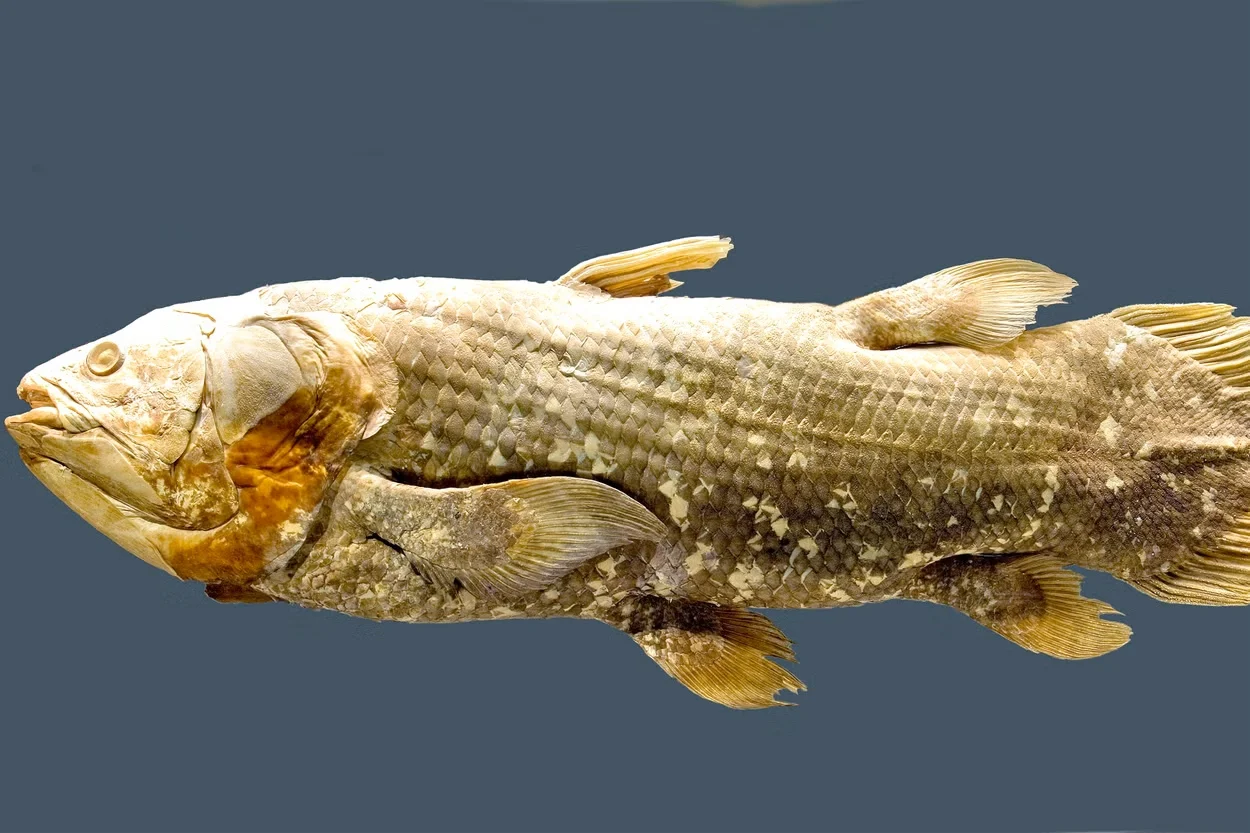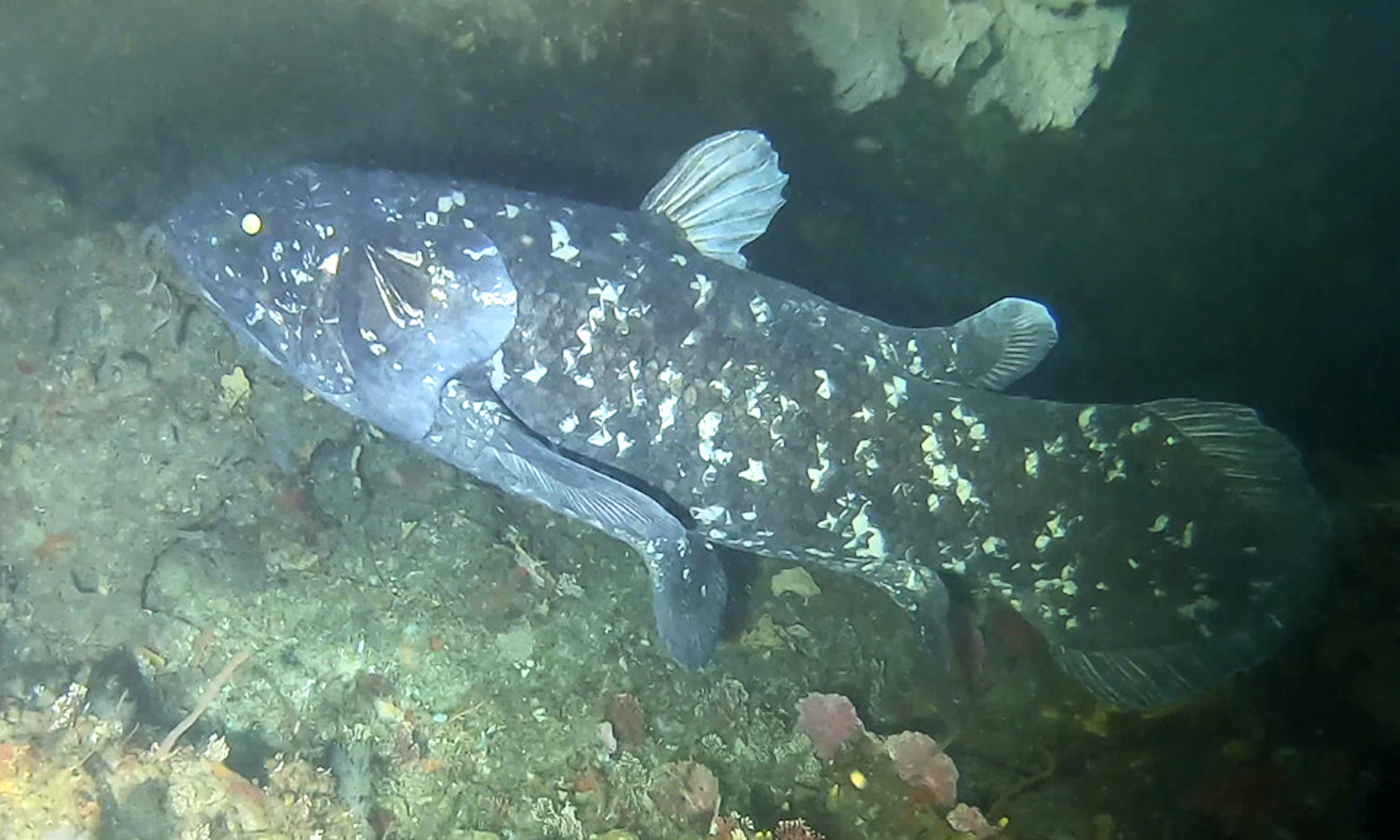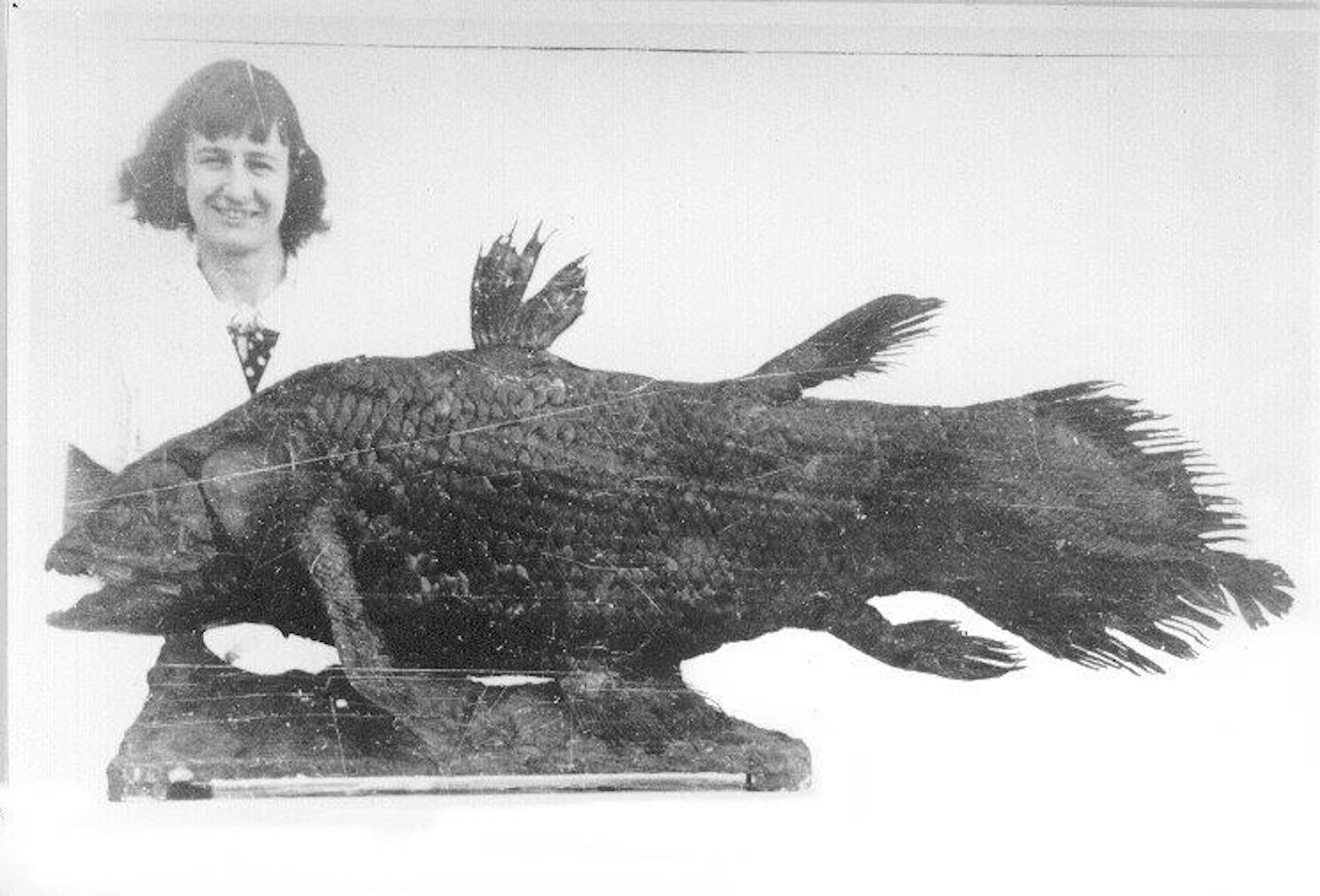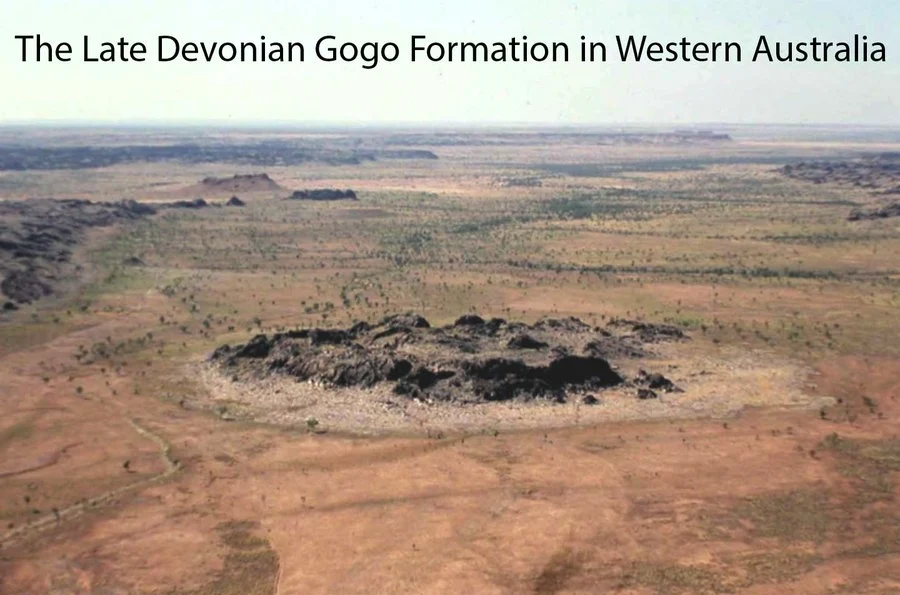Exceptional new fish fossil sparks rethink of how Earth’s geology drives evolution
In that strange logic that passes for rational thought in creationist circles, creationists will tell you that the 'fact' that coelacanths haven't changed for millions of years 'proves' the Theory of Evolution is false. Also, the 'fact' that scientists used to think coelacanths were extinct until one was caught, 'proves' science is all wrong, so Earth is only a few thousand years old [sic].
But of course, as with every other 'proof' of creationism, the 'facts' presented are in fact lies, intelligently designed by cult leaders to appeal to the child-like minds of creationists desperate for real-world evidence for their inherited superstition.
Firstly, coelacanths are not a species but a family consisting of several genera and they have changed over the millions of years between the most recent fossil and today and in its heyday, there were over 175 known species so far identified in the fossil record.
Secondly, the fact that scientists thought the entire family was extinct was simply based on the sudden disappearance of them in the fossil record and the fact that no living specimens had been seen - until one was caught. Scientists then changed their minds because the facts changed. The 'extinction' of the coelacanths was not a central part of the Theory of Evolution.
What can you tell me about the coelacanths of the Late Devonian? Coelacanths of the Late Devonian period are some of the most fascinating ancient fish due to their long evolutionary history and unique biology. Coelacanths belong to the subclass Actinistia, a group of lobe-finned fish that are distinguished by their paired limb-like fins, which are supported by robust bones.Now, a team of scientists, led by Dr Alice M. Clement, Dr Richard Cloutier and Professor John A. Long of Flinders University, Adelaide, Australia, have published the results of their examination of one of the best preserved fossil coelacanths, open access, in the journal Nature Communications, and have shown how in fact there was considerable evolution within the group over time; moreover, the environmental change that drove this diversity was none other than plate tectonics.
Here are key points about coelacanths in the Late Devonian:
Coelacanths of the Late Devonian represent a key stage in vertebrate evolution, bridging the gap between fish and the first tetrapods. Their survival and adaptability in ancient seas offer insights into the resilience of life through changing climates and mass extinctions.
- Evolutionary Origin:
- Coelacanths first appeared during the Devonian period (around 400 million years ago) and flourished in both marine and freshwater environments.
- By the Late Devonian, coelacanths were part of a diverse array of lobe-finned fishes, a group that includes the ancestors of tetrapods (four-limbed vertebrates).
- Distinct Anatomy:
- Coelacanths possessed fleshy, lobed pectoral and pelvic fins with bones similar to the limbs of land vertebrates.
- Their fins were thought to have played a role in maneuvering across the seabed, suggesting a semi-benthic lifestyle, though this remains a debated topic.
- They had a distinctive three-lobed tail, or trilobed caudal fin, which set them apart from most other fish.
- Respiratory and Buoyancy Adaptations:
- Coelacanths had a vestigial lung, an air bladder that was likely used for buoyancy control. This primitive lung is a vestige from when they may have inhabited low-oxygen environments.
- Their electroreceptive organ in the head (rostral organ) suggests they could detect prey through electrical signals in murky or dark waters.
- Role in Devonian Ecosystems:
- Coelacanths were likely carnivorous, preying on smaller fish and invertebrates.
- The Late Devonian was a time of great marine biodiversity, but also a period of significant environmental change. coelacanths managed to survive the Late Devonian extinction events, which wiped out many other marine species.
- Fossil Record:
- Coelacanth fossils from the Devonian show that they were relatively small, around 30-40 cm in length, and they had a more diverse morphology compared to the modern-day species (Latimeria).
- Fossils of early coelacanths have been found in regions such as Europe, North America, and Africa.
- Survival Through Extinctions:
- Remarkably, coelacanths survived multiple mass extinction events, including the Late Devonian extinction (~375 million years ago). They persisted into the Mesozoic and beyond.
- They were long thought to have gone extinct until their discovery as "living fossils" in 1938 off the coast of South Africa.
Two of the authors, Dr Clement and Professor Long, have written about these findings in The Conversation. Their article is reprinted here under a Creative Commons license, reformatted for stylistic consistency:

Exceptional new fish fossil sparks rethink of how Earth’s geology drives evolution
An illustration of the Ngamugawi wirngarri coelacanth in its natural habitat.
Katrina Kenny
Coelacanths are deep-sea fish that live off the coasts of southern Africa and Indonesia and can reach up to two metres in length. For a long time, scientists believed they were extinct.
In new research published in Nature Communications, we reveal the best-preserved coelacanth fossil ever found from the ancient period hundreds of millions of years ago when these ancient sea-dwellers first evolved. The fossil comes from the Gogo Formation on Gooniyandi Country in northern Western Australia.
We also studied the evolution of all the hundreds of coelacanth species we know from the fossil record to find out what drove the creation of new species across the aeons.
The answer came as a surprise: the greatest influence on coelacanth evolution was not ocean temperature or oxygen levels but tectonic activity. When the vast plates of Earth’s crust were moving around more, new species were more likely to appear.
‘Living fossils’
coelacanths are “lobe-finned” fish, which means they have robust bones in their fins a bit like the bones in our arms. Scientists believe they are more closely related to tetrapods (animals with backbones and four limbs, such as frogs, emus and humans) than to most other fishes.
coelacanths have been around for a long time. The oldest known fossils are more than 410 million years old. But because these fossils are mostly fragments, we don’t know a lot about what the earliest coelacanths were like.
Later, during the age of dinosaurs which began around 250 million years ago, coelacanths became more diverse. In total, we have found traces of more than 175 fossil species from all over the globe.
Finally, at the end of the Cretaceous period, 66 million years ago, all signs of coelacanths mysteriously vanished from the fossil record. For a long time, scientists assumed the coelacanths were casualties of the massive asteroid impact that also signed the death warrant of the dinosaurs (along with around three-quarters of all life on Earth).
All that changed in 1938, when fisherpeople in South Africa pulled a large, enigmatic fish from the ocean depths that was like nothing they had seen before. A local museum employee with a keen interest in the natural sciences, Marjorie Courtenay-Latimer, immediately knew the fish was special.
Courtenay-Latimer enlisted her friend J. L. B. Smith, a renowned South African chemist with an interest in ichthyology (the study of fish). Smith identified and named Latimeria, the first living coelacanth known to science.
Discovering this “Lazarus fish” was like stumbling across a live Triceratops dinosaur still roaming the forests of North America today. Even today, coelacanths are often described as “living fossils”.
A new fossil coelacanth
Our team from Flinders University, together with other colleagues from Australia, Canada and Europe, discovered a new species of fossil coelacanth on Gooniyandi Country in northern WA. Around 380 million years ago, the site was a tropical reef teeming with more than 50 species of fish.
Ngamugawi wirngarri, the new fossil coelacanth, is the first fish found in the area to bear a name given to us from the Gooniyandi language. The name means “ancient fish in honour of Wirngarri”, a respected elder of the community.
Ngamugawi is the best three-dimensionally preserved coelacanth from the Devonian Period (359 million to 419 million years ago). This fossil provides a great insight into the early anatomy of this lineage.
A digital 3D reconstruction of the skull of Ngamugawi wirngarri, a new Devonian coelacanth from the Gogo Formation.
Reconstruction by Alice Clement.
Our study of the new species led us to analyse the evolutionary history of all known coelacanths. In doing so, we calculated the rates of evolution across their 410 million year history.
We found that coelacanths have generally evolved slowly, with a few intriguing exceptions.
Furthermore, we analysed a series of environmental factors that we considered potential candidates for influencing coelacanth evolutionary rates. These included tectonic plate activity, ocean temperatures, water oxygen levels, and atmospheric carbon dioxide levels.
Of all the variables we looked at, the one with the greatest influence on the rate of coelacanth evolution was tectonic plate activity. New species of coelacanth were more likely to evolve during periods of heightened tectonic activity, as seismic movement transformed habitats.
Are coelacanths still evolving?
Along with our analysis of all fossil coelacanths, we also had a close look at the two living species, Latimeria chalumnae and Latimeria menadoensis.
At first glance, these fish look almost identical to some of their counterparts from hundreds of millions of years ago. However, on closer analysis we could see they were in fact distinct from their extinct relatives.
While Latimeria has essentially ceased evolving new features, the proportions of its body and the details of its DNA are still changing a little. So perhaps it’s not a “living fossil” after all.
Alice Clement, Research Associate in the College of Science and Engineering, Flinders University and John Long, Strategic Professor in Palaeontology, Flinders University
This article is republished from The Conversation under a Creative Commons license. Read the original article.
AbstractThe coelacanths remind us that there can be long gaps in the fossil record, as we would expect of the fossil record, given the rarity of fossilisation and the rarity of finding them. Only creationists who have been fooled into thinking the entire Theory of Evolution hangs on the fossil record and includes a requirement that there be a continuous record with no gaps for every species, like to imaging these predictable gaps destroy the theory, and mean their magic invisible friend created everything by magic just a few thousand years ago.
The living coelacanth Latimeria (Sarcopterygii: Actinistia) is an iconic, so-called ‘living fossil’ within one of the most apparently morphologically conservative vertebrate groups. We describe a new, 3-D preserved coelacanth from the Late Devonian Gogo Formation in Western Australia. We assemble a comprehensive analysis of the group to assess the phylogeny, evolutionary rates, and morphological disparity of all coelacanths. We reveal a major shift in morphological disparity between Devonian and post-Devonian coelacanths. The newly described fossil fish fills a critical transitional stage in coelacanth disparity and evolution. Since the mid-Cretaceous, discrete character changes (representing major morphological innovations) have essentially ceased, while meristic and continuous characters have continued to evolve within coelacanths. Considering a range of putative environmental drivers, tectonic activity best explains variation in the rates of coelacanth evolution.
Introduction
Coelacanths are evolutionarily unique, lobe-finned fishes that first appeared in the fossil record in the Lower Devonian Period (late Lochkovian, ~ 419–411 million years ago [Ma])1, with over 175 fossil taxa described throughout the Palaeozoic and Mesozoic eras. Since the discovery of Latimeria chalumnae by Western scientists in 1938, the phylogenetic relationships among coelacanths have been investigated in more than 20 studies (see Supplementary Text for full list). In most analyses, a good congruence exists between the phylogeny and the stratigraphic record. Coelacanths are considered to be morphologically conservative in terms of body plan2,3,4,5,6,7 and they achieved a peak of diversity during the Triassic6,8,9,10,11. Meanwhile, rates of morphological evolution have been examined stratophenetically12 and phylogenetically3,9,13, indicating that there was an early burst of evolution during the Devonian followed by a precipitous decrease and then a steady, low rate of morphological evolution. However, no driver has ever been proposed to explain these distinctive evolutionary dynamics of coelacanths, nor has their status as ‘living fossils’ been quantitatively evaluated.
Devonian coelacanth material is rare, representing only a small component of the ~175 fossil coelacanth species—there are only 20 known taxa, about half of which are too incomplete to describe formally. Their earliest fossils (Early Devonian) are known from mostly isolated bones from the late Lochkovian and Pragian of China1,14 and the mid–late Pragian of Australia15. Most Devonian coelacanths are rare and fragmentary, except for the middle Frasnian Miguashaia bureaui from eastern Canada16,17, and the late Famennian Serenichthys kowiensis18 based on juvenile specimens from South Africa. Until now, Diplocercides kayseri19 from Gerolstein in Germany is the only Devonian coelacanth known from three dimensions (3-D) and revealing part of the neurocranium, but it has since been destroyed by serial grinding.
The material presented here, comprising two specimens (Fig. 1), represents the first-known coelacanth from the Late Devonian Gogo Formation of Australia20,21,22,23,24,25. Exceptional 3-D preservation of our specimens facilitates rare insight into the neurocranial, branchial, and palaeoneurological conditions of the group. These data also allow us to re-evaluate the phylogeny and phenotypic evolution of all coelacanths in detail, using an expanded character matrix, as well as the first geometric morphometric study of the group to our knowledge, and an analysis of putative drivers of evolutionary rates. Along with this description, such an expansive time series of detailed evolutionary patterns for a single taxon extending right up to the present offers an opportunity to determine the global processes steering evolution more generally.Fig. 1: Acid prepared material and skull reconstruction of Ngamugawi wirngarri gen. et sp. nov. A, B ‘Part a’ of WAM 09.6.148 (holotype) shown in left dorsolateral view and skull close up in left lateral view. C ‘Part b’ of WAM 09.6.148 (holotype) showing all exposed elements; D partial braincase of NMV P231504 (paratype) shown in right lateral view; E cleithrum of NMV P231504 (paratype) in mesial and lateral view; F, G skull reconstruction in dorsal and left lateral view. Abbreviations: Ang angular, Cl cleithrum, Clv clavicle, Dt dentary, Exc extracleithrum, icj intracranial joint, ioc infraorbital canal, L.Gu lateral gular, Lj lachrymojugal, mc mandibular canal, L.Ex lateral extrascapular, Op operculum, Par Parietal, Po postorbital, Pop preoperculum, Pp postparietal, Pmx premaxilla, Psym parasymphysial, Q quadrate, Ro.p1 anterior pore of the rostral organ, Ro.p2 antero-lateral pore of the rostral organ, Ro.p3 postero-lateral pore of the rostral organ, So supraorbitals, soc supraorbital canal, Sop Suboperculum, Spl splenial, Sq squamosal.
A, B ‘Part a’ of WAM 09.6.148 (holotype) shown in left dorsolateral view and skull close up in left lateral view. C ‘Part b’ of WAM 09.6.148 (holotype) showing all exposed elements; D partial braincase of NMV P231504 (paratype) shown in right lateral view; E cleithrum of NMV P231504 (paratype) in mesial and lateral view; F, G skull reconstruction in dorsal and left lateral view. Abbreviations: Ang angular, Cl cleithrum, Clv clavicle, Dt dentary, Exc extracleithrum, icj intracranial joint, ioc infraorbital canal, L.Gu lateral gular, Lj lachrymojugal, mc mandibular canal, L.Ex lateral extrascapular, Op operculum, Par Parietal, Po postorbital, Pop preoperculum, Pp postparietal, Pmx premaxilla, Psym parasymphysial, Q quadrate, Ro.p1 anterior pore of the rostral organ, Ro.p2 antero-lateral pore of the rostral organ, Ro.p3 postero-lateral pore of the rostral organ, So supraorbitals, soc supraorbital canal, Sop Suboperculum, Spl splenial, Sq squamosal.
Clement, A.M., Cloutier, R., Lee, M.S.Y. et al.
A Late Devonian coelacanth reconfigures actinistian phylogeny, disparity, and evolutionary dynamics.
Nat Commun 15, 7529 (2024). https://doi.org/10.1038/s41467-024-51238-4
Copyright: © 2024 The authors.
Published by Springer Nature Ltd. Open access.
Reprinted under a Creative Commons Attribution 4.0 International license (CC BY 4.0)
What Makes You So Special? From The Big Bang To You
How did you come to be here, now? This books takes you from the Big Bang to the evolution of modern humans and the history of human cultures, showing that science is an adventure of discovery and a source of limitless wonder, giving us richer and more rewarding appreciation of the phenomenal privilege of merely being alive and able to begin to understand it all.
Available in Hardcover, Paperback or ebook for Kindle
Ten Reasons To Lose Faith: And Why You Are Better Off Without It
This book explains why faith is a fallacy and serves no useful purpose other than providing an excuse for pretending to know things that are unknown. It also explains how losing faith liberates former sufferers from fear, delusion and the control of others, freeing them to see the world in a different light, to recognise the injustices that religions cause and to accept people for who they are, not which group they happened to be born in. A society based on atheist, Humanist principles would be a less divided, more inclusive, more peaceful society and one more appreciative of the one opportunity that life gives us to enjoy and wonder at the world we live in.
Available in Hardcover, Paperback or ebook for Kindle










No comments :
Post a Comment
Obscene, threatening or obnoxious messages, preaching, abuse and spam will be removed, as will anything by known Internet trolls and stalkers, by known sock-puppet accounts and anything not connected with the post,
A claim made without evidence can be dismissed without evidence. Remember: your opinion is not an established fact unless corroborated.